In modern home canning, the accepted rule of thumb for safe vinegar / water pickling solutions is that the vinegar should be of at least 5% acidity, and that the vinegar ratio in that mix should be a minimum of 50%. So that is, 50 % of 5% acid vinegar / 50% water.
It’s fine to raise the vinegar to 60% and lower the water to 40%, but you can’t do the opposite: it’s not okay to lower the vinegar.
If a recipe calls for 100% vinegar, you must use 100% vinegar and can’t replace any of it with any water. If a recipe calls for a pickling mixture of vinegar and water, it’s okay (food-safety-wise) to replace some or all of the water with vinegar — provided you don’t mind the pucker power!
There’s always annoying exceptions in canning rules, and this is no exception: you will see approved and tested recipes with a lower vinegar / higher water ratio in lab-tested recipes from Ball, Bernardin, NCHFP, USDA, University Extensions, etc. The reason that is fine is because those recipes were lab-tested, giving the clearance for those exceptions.
But, should you be assessing a recipe from somewhere else, that 50 % vinegar ratio is the lowest proportion of vinegar considered safe in a pickling mixture if you are not using a tested, approved recipe — which, to be clear, you should be. This page and discussion is an intellectual exercise only!
On this page, we’re going to show you just how safe the tested recipes are. To be clear, the goal is not to encourage anyone to muck with acidity levels or invent their own recipes, but rather, it’s to assure them of the complete safety of tested home canning recipes from reputable sources.
Note: all vinegar sold in North America is diluted down by manufacturers to the strength desired for a given product. When we talk below about diluting the vinegar down, what is meant is adding water to the 5% acetic acid strength vinegar as sold (which of course has already been diluted down from 100% concentrated vinegar.)
Where does the 50 / 50 rule come from?
At this point (2016), we haven’t succeeded in tracking down the actual origin of the rule: who first said it, or did the research that established it.
Here are two reputable sources supporting it, though.
North Carolina Cooperative Extension Service says,
Vinegar must be at least 5 percent acetic so that low acid vegetables such as cucumbers are properly acidified. Never dilute the amount of vinegar stated in a recipe. For every cup of water, add 1 cup of vinegar.” [1]Henderson, Judy and Carrie Thompson. Making Pickles in North Carolina.
North Carolina Cooperative Extension Service. FCSW-497-06. January 2001.
The Washington State University Food Safety Advisor Handbook (March 2015), which is used to train Master Food Preservers, says in the section on “Preparation and Canning of Pickled Foods” under Ingredients/Vinegar:
“…fresh-pack or quick pickle recipes are considered safe if the ratio of vinegar to water or other liquid is at least 1:1. The proportion of vinegar can be higher, and in some recipes vinegar makes up all the covering liquid”.
Some quick background about pH
Unless something is going to be pressure canned, then to be home canned a food product needs to be water bathed AND have a pH of less than 4.60.
The pH scale goes from 0 to 14. The lower the number, the more acidic it is, which is what we care about. (7.0 is considered the middle — neutral; above that up is considered alkaline.)
The pH scale is a bit like the Richter earthquake scale, in that a teeny increment matters. In the pH scale, 2.0 is 10 times more acidic than 3.0, because it’s 10 x .1 increments lower than 3.0, and the closer you get to 0 the more acidic something is.
In home preserves, pickles, relishes, jams, jellies, chutneys, etc, you want a pH lower than 4.60. The reason 4.60 is the magic number is because above that botulism can form. So, we want to stay below that. Ideally, well below that.
If you want more information than that, see The Role of pH in Home Canning.
The average pH range of standard North American white distilled vinegar is 2.4 to 2.6. The average pH range of distilled water is 7.0.
The worries
The safe canning police bandy about the big B clobber word so much that they get people starting to imagine things they should be afraid of. One of the things that some people consequently worry about is if the alkalinity of their local tap or well water will negate the acidity of the vinegar, raising the combined pH above 4.6 and rendering their pickling mixtures unsafe.
If this has ever occurred to you, when you see how much water is needed to nudge the pH down by increments, you may sleep a bit easier at night.
Before we get started
Before we start, we have to calibrate the pH meter. You have to calibrate it at the start of each session. It’s a pain, certainly, but pH readings are one of those things that are only worth doing if you do them completely right.
To calibrate, we put the pH meter tip first in the 7.0 solution, click the accept button when it reads that number, rinse the probe tip in distilled water, then take the reading of the 4.01 solution, then rinse the probe tip again.
For more information, see pH Meters and Home Canning.
We are done calibrating.
Out of pure curiosity, let’s verify the pH of the distilled water and of the vinegar.
Yep, the distilled water comes in at 7.0 [2] Note: at least one meter maker says that pH meters can’t accurately read distilled water owing to the lack of ions on it, and that the readings will drift. This reading did in fact start to drift after a while, but this reading was just for curiosity, anyway. https://www.vernier.com/til/1286/ Accessed June 2015
Now, let’s satisfy our curiosity about the white distilled vinegar.
The white distilled vinegar comes in at 2.46, smack in the middle of the average 2.4 to 2.6 range.
So, that’s great. Everything that we have been given to expect, is proving correct.
Now, we’ll start the actual testing.
Testing the pH of various strengths of vinegar / water mixtures
Let’s now dilute the vinegar by 25% with water.
The starting pH of the vinegar was 2.46.
By diluting it with ¼ water, we raised the pH from 2.46 to 2.49: only 0.03.
Let’s now dilute the vinegar by 50% with water.
The starting pH of the vinegar was 2.46.
By diluting it with ½ water, we raised the pH from 2.46 to 2.60: an increase of 0.14.
This ratio, by the way, is the lowest generally-accepted (barring lab-tested exceptions) minimum amount of vinegar with water pickling solution for home canning: 50 / 50
Let’s now dilute the vinegar by 75% with water. This is past the approved range, but this is just an experiment.
The starting pH of the vinegar was 2.46.
By diluting it with ¾ water, we raised the pH from 2.46 to 2.75: an increase of 0.29.
Conclusion
It appears to take substantial increases in the proportion of water to increase pH by just 0.1 steps.
But water isn’t added just via a measuring jug: there’s also water in the cucumber, peppers, onions, carrots, celery, etc. that gets released and floods into the food mixture. And, don’t forget, most approved canning recipes are written in maddeningly imprecise measurements such as “2 cups cut-up rhubarb”, which people are going to interpret in wildly different fashions and end up with wildly different quantities of “fruit water” being released into the mixture in the pot.
So it’s likely they picked the 50 / 50 ratio to well and truly account for those and other variables.
All this should demonstrate just how safe the tested recipes are, and that you can make, use and gift them with confidence knowing that there is a massively huge margin of safety built in. If you are following a tested recipe, even if you interpret the “chop” size of celery different from someone else, you are both well and truly covered.
Don’t overboil your relish, chutney and pickling liquid mixtures
That being said, there is apparently a minor word of caution. Any cooking of the relish, chutney, or pickling solution evaporates some of the acidity in the mixture away. That may be yet another reason they allow such a huge safety margin, to allow for that loss.
Still, author Linda Ziedrich advises,
Take care not to boil pickling liquid for a long time, since acetic acid evaporates faster than water does. Boil pickling liquid only as long as the recipe calls for. Then, if you’re not ready to use the liquid immediately, remove the pan from the heat and cover it.” [3]Ziedrich, Linda. The Joy of Pickling. Boston, Massachusetts: The Harvard Common Press. 2009. Page 11.
Putting Food By advises,
Avoid boiling for a long time any vinegar solution that is to be used as the canning liquid for pickles, because the acetic acid in vinegar is rather volatile, and it will lose its ability to keep stored pickles safe.” [4] Hertzberg, Ruth; Greene, Janet; Vaughan, Beatrice (2010-05-25). Putting Food By: Fifth Edition (p. 316). Penguin Publishing Group. Kindle Edition.
Note that some relishes and chutneys have you boil the mixture for about an hour: even though they’ll lose some acid owing to evaporation during the cooking, they’ll still be safe (if you’re using a tested recipe) because they will have had you add enough acid at the start to allow for that loss.
Sample exceptions to the rule
Exceptions to the 1:1 vinegar to water rule are lab-tested recipes such as Pickled Grape Tomatoes from the Ball Blue Book [5]Ball Blue Book. Muncie, Indiana: Healthmark LLC / Jarden Home Brands. Edition 37. 2014. Page 94 which uses a 2:4 vinegar to water ratio (owing likely to an assumed border-line acidity level for the tomatoes) and Quick Fresh-Pack Dill Pickles from the USDA [6]United States Department of Agriculture (USDA). Complete guide to home canning. Agriculture information bulletin No. 539. 2015. Page 6-10 which uses a 3:4 vinegar to water ratio.
References

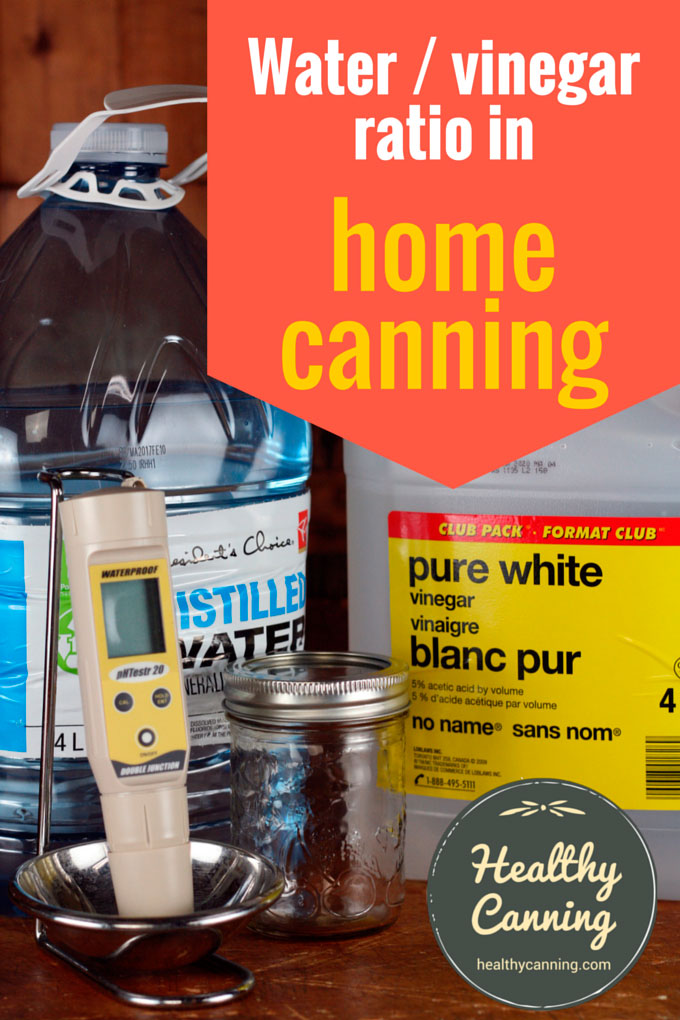
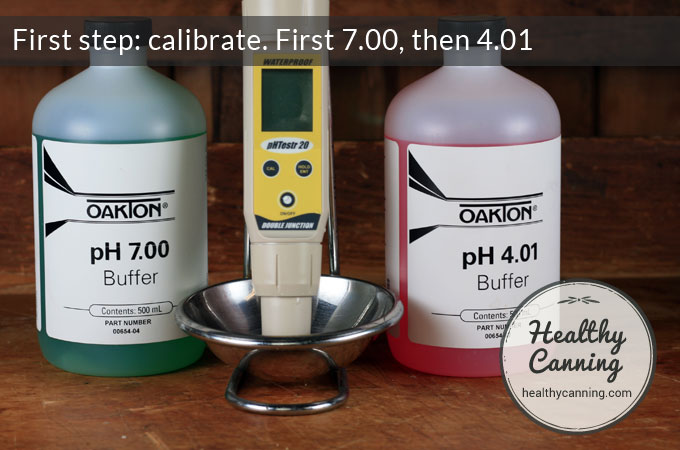
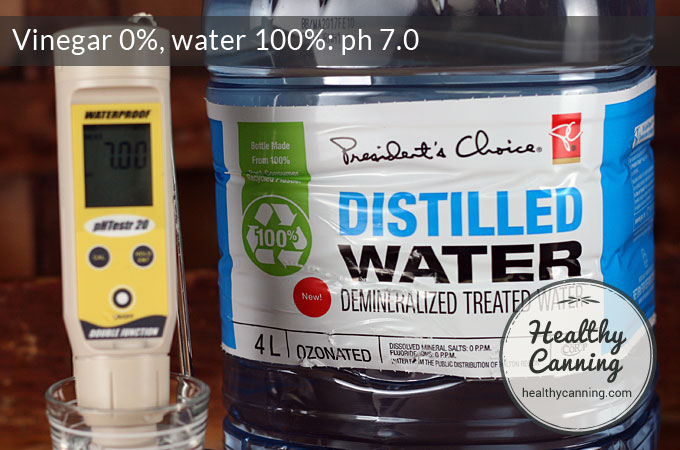
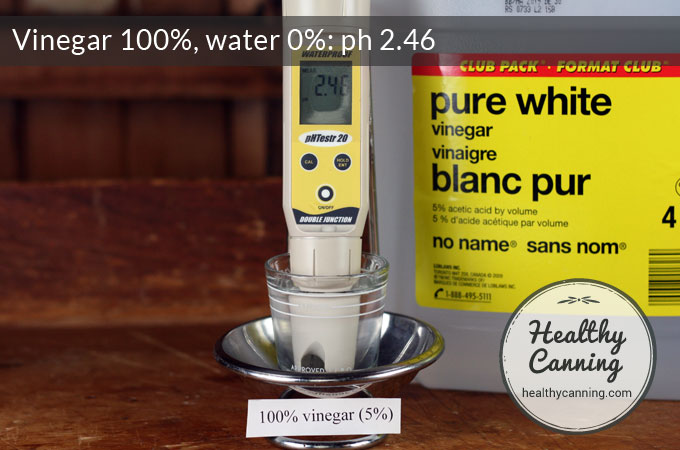
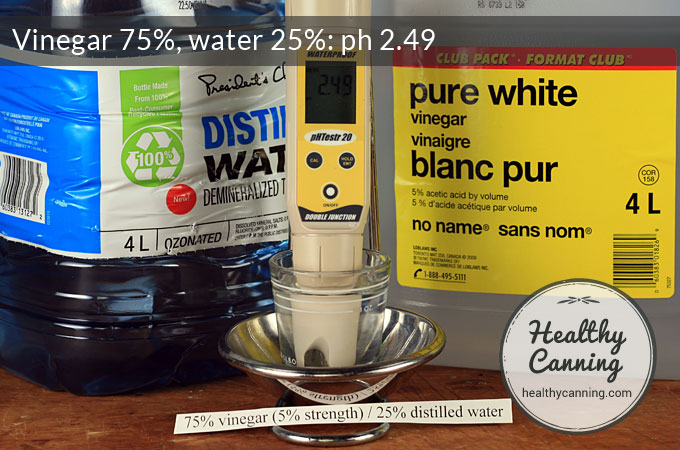
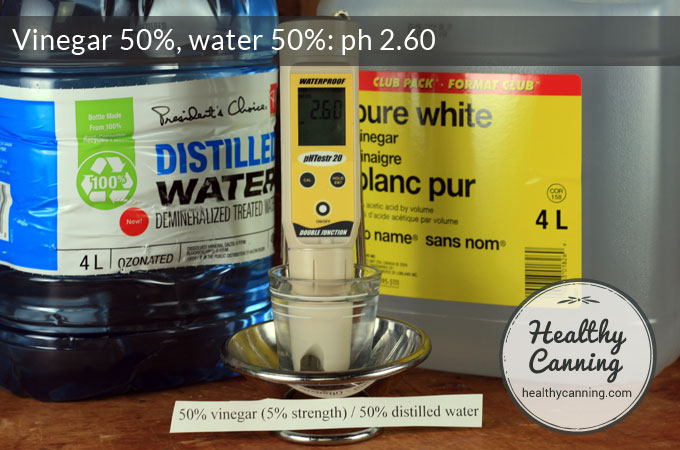
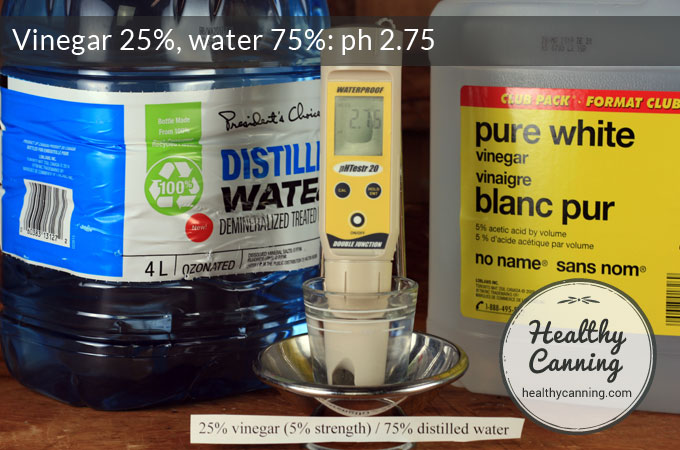
Harry
I can’t get 5% vinegar where I am, but I can get 6% vinegar. If I want to dilute it down to 5%, is it as simple as adding water at 20% of the total volume?
So for example, if I have one liter of 6% vinegar, can I then add 0.2 liters (200mls) of water to it to make it 5% vinegar?
Also, is tap water fine, or do I need to use distilled water?
Thanks.
Healthy Canning
It’s okay to use 6% undiluted! There is no need to use distilled water.
Julyn
Hi, I have tried making cucumber slice in pickle brine but it turns wrinkles in 24 to 48 hours. Salt is about 20% and pH of the brine is around 3 without heat treatment; soaking cucumber slices and store them in fridge. What can I do to avoid shriveling and this shrunken/wrinkle appearance of my cucumber slice to keep them longer?
Clarke De Pastino
I recently pickled cucumbers using a not tested recipe of 2/3 cup vinegar to 1 cup water. They were hot packed and put into a water bath for the recommended time of 10 mins. I dread to think they could all be trash. If I buy a PH meter and test the jar upon opening for a PH under 4.6, if this an accurate indicator that they are safe? Or do I need to just throw them away and not bother?
Healthy Canning
Hi Clark, ask one of these Master Food Preserver groups what they feel.
Janet Hendricks
I am looking for a recipe to can pickled hard boiled eggs. Either mustard or red beet, both if available. Thank you
Healthy Canning
No safe canning recipes for pickled eggs. Store in fridge.
Sheila
Can I test home canned pickled beets with paper ph strips to check for safety
Healthy Canning
Just follow a lab-tested recipe from a reputable source.
Don Landry
I read your vinegar to water ratio I’m pretty sure the answer you’re going to give me as it’s not safe. My tried-and-true recipe calls for 9% vinegar one and a half cups and 6 cups of water. I forgot the 9% vinegar and use 5% do you think I am in danger of food spoilage? Thank you so much for your time
Marshall
For years, I’ve pickled raw mirlitons in 100% white vinegar and dry spices, then refrigerate. No problems….am I safe, or lucky?
Healthy Canning
It is safe to pickle and store mirlitons (aka chayote) in that way.
Bob Needham
Hi all, we have been holding a family pickle making day ( Indian eggplant pickle ) which my mother brought to Australia many years ago and we have produced this lovely spicy pickle for many years, but in recent years we have been reducing the vinegar levels but also finding that some batches have been “going off ” so when you take the lid off the pickle is fermenting and spoilt.. This pickle uses fresh fruit including chilies and various spices plus oil and vinegar NO Water it is also cooked at a simmer for approx an hour, can you advise what PH the pickle should end up at and what the Vinegar / oil ratio should be to get the required PH level. Also we have been cooking in the afternoon and cold botteling in sterilised jars the next morning is this OK?? I would love to get some feedback from you on this. Thanks in advance
Cheers Bob Perth Australia
Healthy Canning
Bob, I can’t comment on correcting old “family” recipes. I can only advise to use tested recipes from reputable sources.
(a) For pickled stuff, you have to make sure that you have an acidic environment (pH of 4.6 or lower) in the jar, and that that pH has been achieved right in the middle of each piece of ingredient. Any higher, and any botulism spores present can spring to life. (Acidity doesn’t kill botulism spores, but it prevents them from doing anything….) Don’t play with acidity when it comes to eggplant, just too many cases of it going to the really bad place….
(b) Proper pH alone though is not enough. All filled jars of must be heat processed (for high-acid pickled foods, via a water bath or steam canner.) Sterilizing empty jars in advance does no good, you might as well whistle Dixie. Otherwise, moulds and other nasties such as salmonella, listeria, etc which don’t mind an acidic environment can flourish and cause spoilage, as you are experiencing. Moulds seen and unseen can lower the acidity and allow any dormant botulism spores to spring to life. Only heat processing of a closed, filled jar is going to get them all. The problem is knowing how long to heat process, for the size of jar and the density of the food material in it.
So I can only advise to do one of three things, neither of which is going to make you happy :}
(1) Look for a similar tested recipe from a reputable source, and switch to using that.
(2) Take your recipe to a testing authority, and for a couple hundred bucks or so get them to test it for you and make recommendations. Not sure if such places are as common in Australia and accessible to small undertakings as they are in North America.
(3) Refrigerate or freeze it instead of attempting to make it shelf stable, and all your problems go away. It sounds a bit like a take on “Brinjal Pickle”, which is best stored in the refrigerator.
As minor compensation, here’s a tested recipe for an Indian chutney which is delicious : https://www.healthycanning.com/indian-apple-chutney/
Joe
I’m having trouble finding a source that corroborates boiling pickling liquid decreasing the concentration of acetic acid. The boiling point of water is lower than acetic acid so even if you’re boiling both, you always boil off more water than acid. Do you have any other sources on this?
Healthy Canning
That’s a very valid question, Joe! Ask Linda Ziedrich directly where she got her information from for that quote. Her website is here, I’d be interested as well to hear … https://agardenerstable.com/
Mike
Trying to preserve my organic garlic in 5% organic apple cider vinegar but heard that it’s Ph was about 4.
Can I use it?
Healthy Canning
Here’s a tested recipe for pickled garlic. You can swap in apple cider vinegar (5% or higher) for the vinegars in the recipe. https://www.bernardin.ca/recipes/en/pickled-garlic.htm Do not skip the processing recommendations.
(p.s. whether something is organic or not is irrelevant to home canning safety :})
Rich
I pickled green beans for the first time, and the recipe called for 60/40 vinegar/water. So that’s good. I may have let the mixture boil a bit longer than recommended, so that’s bad. Can I use a ph meter AFTER the pickles have sat on the shelf for 3-4 weeks? I think I’m just being paranoid, and I’m excited to try my tasty snack, but better safe than sorry.
What would you recommend I do?
Healthy Canning
The vinegar / water ratio sounds good. Yes, a pH meter can be used at any time. But honestly if you used a tested recipe from a reputable source, it will be fine — I wouldn’t go out and buy a pH meter and supplies for it.
Nancy R McNerney
When I make my bread and butter pickles there is no water added at all.
It is equal parts vinegar (5% acidity) and sugar and then some spices.
Without testing my PH levels, do you think that I am below the 4.6 PH level that is important?
I hate to spend the money on the PH tester and the buffers if I don’t really need to.
Thanks!
Healthy Canning
If you used pure 5% vinegar, then the acidity should not be an issue as white refined sugar is pH neutral. Still, on Healthy Canning we can only recommend following tested recipes from reputable sources to ensure proper processing times, etc, if you plan to store jars of the pickles on a shelf (for refrigerated storage, anything goes, even acidity levels.)
Jennifer Kleffner
So, I’ve seen this 50/50 ratio listed here and there, including an article in Mother Earth News, for years. But I’ve never been able to find it in writing from a “tested” source such as the National Center for Home Food Preservation or an extension office. Because I’m trying to get my state government to lighten up on the “you must follow national commercial rules for any “acidified” product – which are way over burdensome for a small canner wanting to sell product at local farmers markets, I’ve been searching for the source of this 50/50 recommendation for quite some time. I even tracked down the email of the author of that Mother Earth News article, but never got a reply back. Thoughts?
Healthy Canning
Hi Jennifer, that’s a very darn good question. I’ve added a section showing what reputable sources cite the rule ( https://www.healthycanning.com/acidity-of-water-and-vinegar-combinations-in-home-canning/#where-does-the-50-50-rule-come-from ) and added to the todo list tracking down a citation for the ultimate source of it, as in who did the research that established that rule of thumb in the first place?